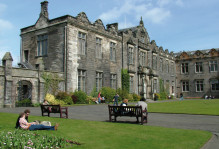The Best of Both Worlds on Both Sides of the Pond
Admit It! It would be cool to have a college degree jointly awarded by two revered institutions that bore the insignia of both wouldn’t it? The new St Andrews William & Mary Joint Degree Programme offers just that and much more. One glimpse at our new programme reveals that this new venture is unique and comprised of two very historic universities. I mention unique because where else can a scholar experience over 900 years of combined history at the alma mater of four presidents and the former home of a future king? Now that we’ve got your attention on the subject, let’s dive into what makes this program an unparalleled opportunity for any student!
Clearly, the biggest advantage of studying abroad in any foreign country is exposure to a different educational system and to a different set of academic values. What Americans view to be a normal college experience is actually quite different from most university systems throughout the world. The UK university experience, and most of Europe, is fairly structured; the first two years include only three introductory courses per semester of a fairly prescribed nature (with some flexibility built into the first year), and the final two years are spent in one subject with very intense and focused study. Students are permitted to progress to the latter two years, or the specific Honours Programme, once work within the first and second level subjects reaches a sufficient level. The Honours Modules (third and fourth year level courses) work terminates in the granting of either First, Second, or Third Class Honours Degrees based upon an evaluation of the work and examinations completed during the last two years. UK students employ certain academic tools, such as small group tutorials, residential reading parties in country homes used by Scottish universities, and independent study in order to successfully pass the notoriously rigorous Honours Modules. This well thought-out system produces analytical, intellectual, and well-versed students within a specific academic area.
The liberal arts approach to education at W&M and other American schools emphasizes not only the importance of obtaining a breadth of not only knowledge (demonstrated by the ability to reproduce facts in a broad range of subjects) but also the ability to synthesize and analyze material from traditional academic genres (ranging from mathematics to philosophy to performing arts.) This emphasis on a number of different academic realms produces well-versed students capable of analytical skills across many areas. The W&M dedication to balance is evident in the fact that our students may begin the day reading the same works inside the same historic walls where our nation’s founders studied, continue on to a science course in our state of the art Integrated Science Complex, followed by practicing with a student singing group and ending the night with a Tribe football game. These varied experiences inside and outside the classroom are what many American students value and anticipate experiencing once in college.
The differences between the US and UK systems exist not only in the structure and philosophy of study, but also in the presentation of material and examination of learned topics. Both W&M and St Andrews offer a “small classroom” environment, however, UK Honours Modules courses are traditionally taught with less than ten students present and occasionally in the historic fashion of a tutor/pupil (or one-on-one instruction between professor and student) module. The distinct difference in the UK approach to higher education is the focus on interpreting taught material in a creative way instead of providing proof of memorized facts. A focused approach to teaching stresses not only retaining the material but also being able to twist, manipulate, and redevelop the very specific area of study is what makes the UK system similar to other nations’ schools and different from our own.
The beauty of the St Andrews William & Mary Joint Degree Programme is that those lucky students admitted will be able to experience the balanced and well rounded education which Williamsburg has produced for over 300 years as well as the ancient education of the United Kingdom grounded in the Middle Ages. At the end of their four year journey between these two institutions, the Joint Degree student will not only obtain facts, theories, and history within a given academic field but will also have the UK advantage of analyzing information from a completely different perspective than the average American student. This hybrid approach to learning will not come at a sacrifice of traditional American college experiences nor at the expense of acquiring a breadth of general knowledge from a liberal arts background. In all actuality, these students will have the opportunity to be even better rounded and well versed on a global playing field and especially throughout the English speaking world.
Want to learn more about the individual majors offered through the Joint Degree Programme? Admit It! You do. Stay tuned for additional blogs on the four majors: English, Economics, History, and International Relations.
Contributed by:
Amanda Norris ’07
Former Assistant Dean of Admission


No comments.
Comments are closed on posts older than one year, but we still want to hear from you. If you have a comment or question for us, please email admission@wm.edu.